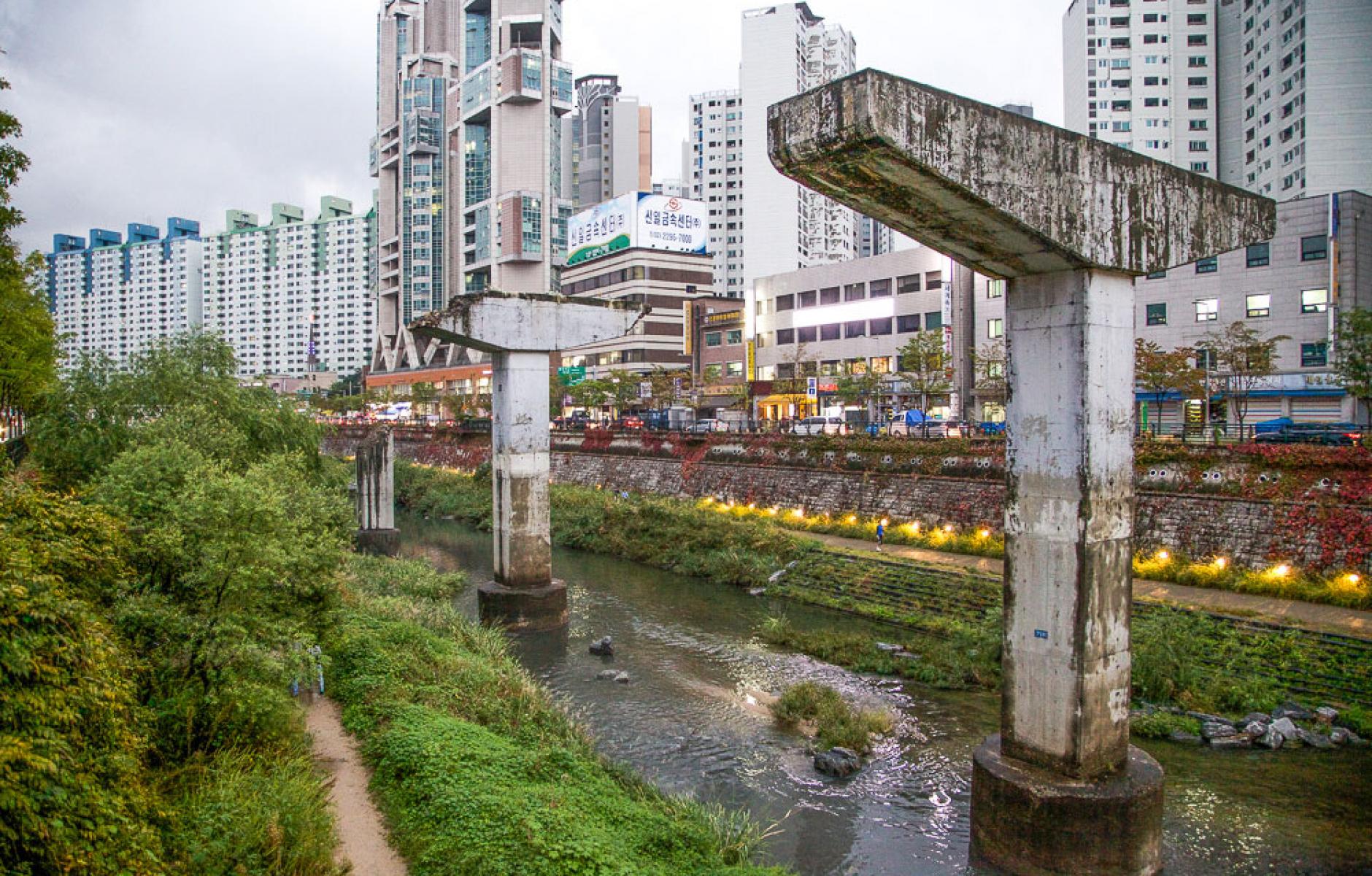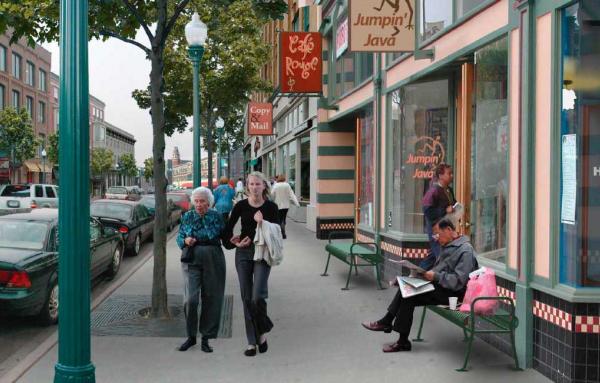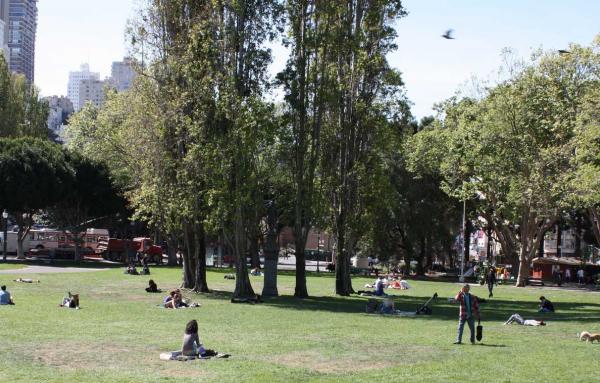
Eight completed highway removals tell the story of a movement
The Highways to Boulevards movement has been advocating for freeway removal for decades and has had success in the US and worldwide. The eight highway transformation featured below illustrate the historical precedent of these projects and the potential impacts and benefits of removing highways from cities.
Chattanooga | Riverfront Parkway
In the 1960s, Chattanooga built a four-lane, limited-access highway along the city’s riverfront. The Riverfront Parkway in Chattanooga, Tennessee, once conceived as a waterfront freight route, quickly became a physical barrier to the city’s riverfront.
The design of Riverfront Parkway became obsolete; in the early 2000s, a plan was finally accepted to replace the four-lane, obsolete highway with a more pedestrian-friendly and easily accessible boulevard.
Riverfront Parkway was converted to a boulevard, allowing pedestrians easy access to riverfront amenities. The boulevard attracted millions of dollars of investment in the area, as the riverfront is becoming one of the city’s premier addresses. A new park has been created that complements the design of the boulevard.

The Cypress Street Viaduct in Oakland was opened in June, 1957, as the first double-decker freeway in California. The highway was built directly through the middle of the West Oakland neighborhood, cutting it in half and isolating it from downtown.
In 1989, the 7.1 magnitude Loma Prieta Earthquake struck the San Francisco Bay Area resulting in the total collapse of the Cypress Street Viaduct between 7th and 18th Streets. Along the highway’s previous route, Oakland built the Mandela Parkway, a four-lane boulevard with a wide, green median that reconnected the formerly bisected West Oakland community.
The parkway boasts many amenities that support walkable, healthy communities and the highway’s removal has led to annual nitrogen oxide levels around the parkway decreasing by 38 percent and annual black carbon levels decreasing by 25 percent. Mandela Parkway has become a new community focal point, promoting connected and active urban life.
In 1950, Harbor Drive became Portland's first limited-access highway with six lanes carrying US Route 99W. In the late 1960s, Gov. Tom McCall pledged his support for the beautification of the west bank of the Willamette River with highway alternatives proposed for the area.
Citizens, led by the Riverfront for Citizens coalition, called for a park and boulevard option. McCall ultimately backed the boulevard and in 1974, Harbor Drive was closed for reconstruction.
In 1978, construction of the 37-acre Waterfront Park was completed and in 1999, the city extended Waterfront Park to the south, doubling the size of the public open space. The success of Portland's downtown is widely known—and the demolition of Harbor Drive should take part of the credit.
The 2.68-mile Inner Loop completely encircled Rochester's central business district. It was a major physical barrier between the downtown and nearby, densely populated neighborhoods built for a more populous city than exists today.
The replacement of the Inner Loop East included filling in the highway trench and building a two-lane street with on-street parking and bicycle lanes on both side of the street.
Since the Inner Loop’s removal in 2017, Rochester has witnessed walking rise by 50 percent and biking increase by 60 percent in the area. The city was also able to reclaim 6.5 acres of land for development, leading to the $22 million highway removal yielding $229 million in development. The City of Rochester is now studying the removal of the remainder of the Inner Loop.

San Francisco | Embarcadero Freeway
San Francisco's Embarcadero Freeway was never completed, and only succeeded in cutting off the city from the waterfront and running long ramps deep into the neighborhood fabric. After the 1989 Loma Prieta earthquake damaged it beyond repair, the costs to rebuild changed the debate in favor of a boulevard.
The boulevard was built in 2002 and the area has sprung to life since the freeway demolition. More than 100 acres of land along the waterfront that had once been dominated by the elevated freeway gave way to a new public plaza and waterfront promenade. Dense commercial development has lined the street, housing in the area increased by 51 percent, and jobs have risen by 23 percent.
When Boston opened the Central Artery highway in 1959, it effectively serviced an estimated 75,000 vehicles daily. The construction of the highway displaced 20,000 residents during construction and cut off Boston’s North End and Waterfront neighborhoods from downtown.
Undertaken in the mid-1990s, Boston’s plan to remediate the congested Central Artery included replacing the six-lane highway with an eight-to-ten lane underground expressway beneath the existing road, ultimately leading to a 14-lane, two-bridge crossing above the Charles River. Upon completion of the underground expressway, the former, elevated expressway was demolished and replaced with open space and urban infill development.
In the path of the old elevated Central Artery now stands the Rose Kennedy Greenway, a 17-acre linear park that links downtown and adjacent neighborhoods that were formerly separated by the highway. Despite cost overruns that led to an unprecedented $21.5 billion final price tag in 2007, The Big Dig has proven successful as a public space and catalyst for development.

In 1968, an elevated freeway covered up the Cheonggye Creek, which ran through a rapidly urbanizing Seoul, hiding the features of its historical waterfront. Just three decades later, the surrounding Cheonggye area recorded the highest levels of noise and congestion in the city.
The highway removal was completed in 2005, and an artificial creek now flows creating a 9 km green swath through the center of the city (see photo at top). The open watercourse handles flooding rains better than buried sewers and brought a 3.3 degree Celsius drop in average summer temperatures in the area adjacent to Cheonggye Creek. The transformation has also boosted Seoul’s tourist economy with half a million visitors visiting the creek each week, making it one of the most popular tourist attractions in South Korea.
Montreal | Bonaventure Expressway
Built for the 1967 World’s Fair, the Bonaventure Expressway was left nearly useless following the Fair’s end, ensnaring future waterfront development, significantly isolating the struggling neighborhood of Griffintown on its western edge, and ultimately paving the way for an auto-oriented downtown.
The City’s modernization plan, Montreal 2025, found that removing the elevated portion of the City-owned Bonaventure Expressway to an at-grade boulevard would be the best alternative to “launch the reunification, on a human scale, of the downtown area with its river.”
Completed in September 2017, two urban boulevards replaced the expressway. The new multi-modal thoroughfare of green spaces, parks, and public art reached many table sustainability goals such as reusing 95 percent of the concrete from the former expressway. In addition, the landscaping manages stormwater on-site and reduces the urban heat island effect with 300 trees and other vegetation.
Feeling inspired? The call for submissions for the 2023 Freeways WIthout Futures report opens in early fall.







